#Ocypode
Text


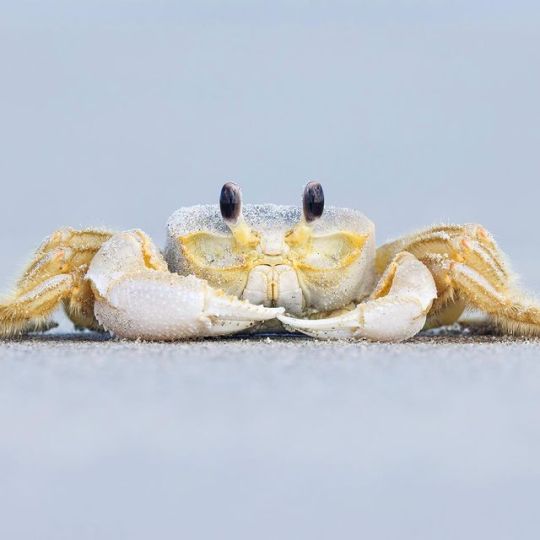
Atlantic Ghost Crab
#atlantic ghost crab#crab#Ocypode quadrata#Malacostraca#Decapoda#Pleocyemata#Brachyura#Ocypodidae#Ocypode#upl
245 notes
·
View notes
Text

Atlantic Ghost Crab (Ocypode quadrata), family Ocypodidae, St. George Island State Park, Eastpoint, FL, USA
photograph by IG: robin.francis.5
141 notes
·
View notes
Text

CRAB IS HERE!! With more crabbies to draw later on!
These are Red Ghost Crabs (Ocypode macrocera) which are found in Pakistan, India, Sri Lanka, and Myanmar
There are many more stickies to come this October, as well as potentially some other forms of merch. This bad boi is already on my Etsy, so check it out! Link is in my bio
#artists on tumblr#art business#small business#australian artist#making stickers#etsy store#etsy seller#star seller#aus creator#aus artist#just silly little guys#ocean themed#ocean themed stickers#marine biology#marine liife#original design#crab sticker#crab#ocypode#ghost crab#red ghost crab#halloween#october#crustacean#crustacean nation#crabs
38 notes
·
View notes
Photo
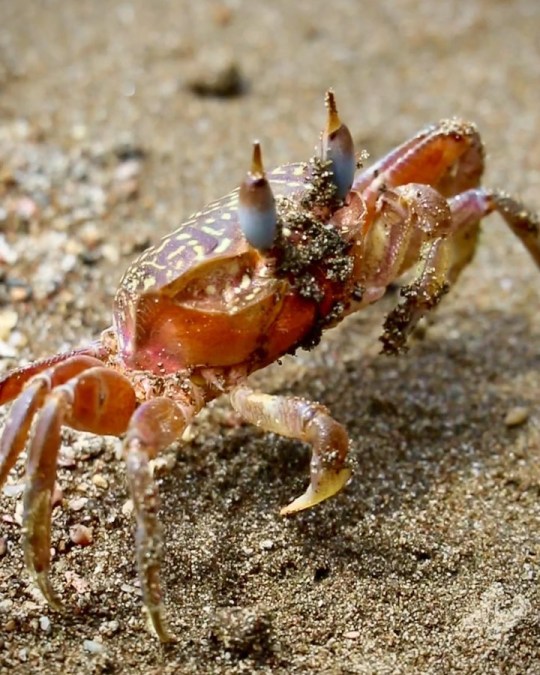
Beste Wohnlage, direkt am Strand. Leider eine Kellerwohnung. 🦀 . #playadominicalito #puntarenas #costarica #costarica🇨🇷 #beachlife #pacific #pacificocean #fernwehfamily #mrcrabs #crab #ghostcrab #ocypode #krabbe #beach #animalphotography (hier: Playa Dominicalito) https://www.instagram.com/p/CoNPPlVsV_8/?igshid=NGJjMDIxMWI=
#playadominicalito#puntarenas#costarica#costarica🇨🇷#beachlife#pacific#pacificocean#fernwehfamily#mrcrabs#crab#ghostcrab#ocypode#krabbe#beach#animalphotography
0 notes
Text

Galapagos Ghost Crab (Ocypode gaudichaudii)
Photo by Ole Jorgen Liodden
#Ocypode gaudichaudii#galapagos ghost crab#crabs#galapagos#red#red crabs#orange#orange crabs#crustaceans#beach#shore#colorful crabs#animals#wildlife#nature
145 notes
·
View notes
Photo

I want to hit him with a hammer until he dies
#crabs#crab post#the little mermaid#the little mermaid Sebastian#ocypode sp. ???#ocypode unidentifiabilis#not true crab
10 notes
·
View notes
Photo

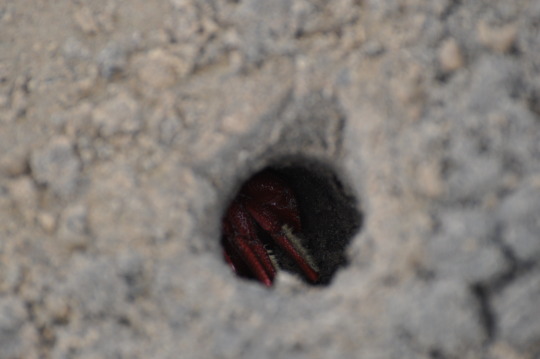
The two vertical eye stalks of the red ghost crab can be swung sideways independently. More specifically a single eye stalk can be lowered sideways by 90 degrees into an oblong furrow in the upper part of the carapace to facilitate its easy and rapid entry, when confronted by predators - human in most instances - into the narrow diameter of its burrow, as can be seen in the first photo, it ready to lunge downwards as I approached, a baleful single eye stalk watching me warily..
In the second photo the beast is snugly ensconced inside the confines of its hole.There is no such thing as claustrophobia in crabs!!!!
Machilipatnam Beach, July 19, 2019. Andhra Pradesh.
#Ocypode macrocera#red ghost crab#eye stalks#swivel#furrow#hollow#Crab hole#beach sand#seashores#machiipatnam#andhra pradesh#Coastal Andhra#predator#claustrophobia#confining#confines#stuffy#narrow#articulation#swing#escape#speed#crustacean#oblong#burrow#celerity#legerity
21 notes
·
View notes
Text
As the first of my inaugural posts that aren’t reblogs: animal friends




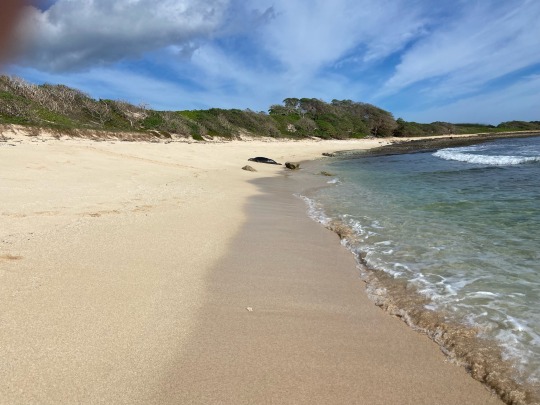
#horned ghost crab#hawaiian monk seal#ocypode ceratophthalmus#neomonachus schauinslandi#Hatima’s animal friends#marine life#crabs#crustaceans#seals
2 notes
·
View notes
Text
Atlantic Ghost Crab, [The Cannibal]
[Ocypode Quadrata]
Ready to learn about the Hannibal Lecter of crustacean family? Hop on board!

Starter : The Atlantic ghost crab, Ocypode quadrata, is a species of ghost crab. It is a common species along the Atlantic coast of the United States, where it is the only species of ghost crab.
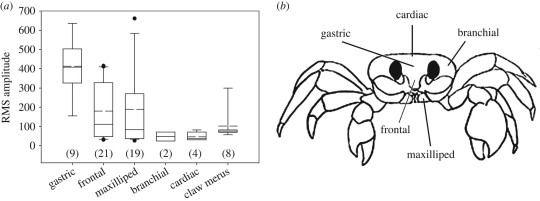
Some fun facts about this good spooky fella!
A 2023 study using the well known mirror test found that these crabs seem to be capable of recognizing themselves in a mirror. They are self-aware.
The atlantic ghost crabs must return to water periodically to moisten their gills, and when larvae must be released into the sea, but they are otherwise terrestrial.
Their stalked compound eyes can swivel to give them 360° vision.

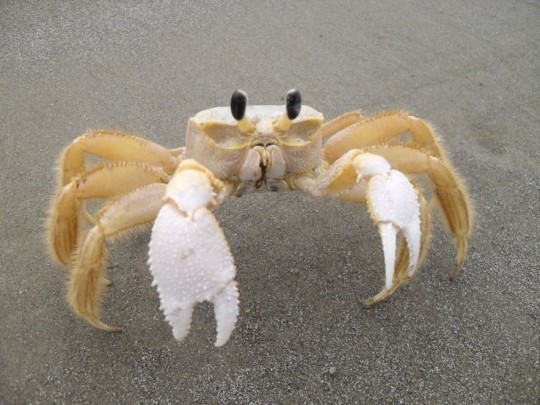

Fun Fact! Ghost crabs are arguably the fastest terrestrial invertebrates, capable of running at more than a meter per second.
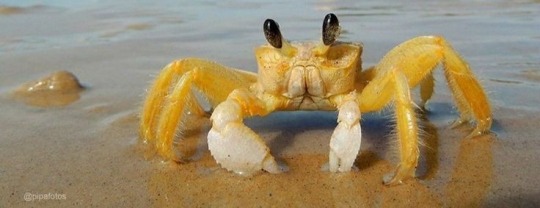
The Atlantic ghost crab lives in burrows (like fiddle crabs!) in sand above the strandline.
These burrows can be up to 1.3 m (4'3) deep, and can be closed off with sand during hot periods.
Young crabs are cryptically colored to blend in with their sandy habitats. This way predators are less likely to see them.
Ghostie mate can produce a variety of sounds by striking the ground with the claw, by stridulation with the legs, and an incompletely explained "bubbling sound"

O. quadrata is more active at night than in the day, and is an omnivore, eating clams, mole crabs, insects, plant material, detritus, and even other crabs. They also feed on the eggs and hatchlings of sea turtles.
CANNIBALISM!? Traitors shall walk the plank!
Ghost crabs are both predators and scavengers, and they feed at night. Their prey can be influenced by the type of beach they live on.
These fuckers arr' also mostly carnivores. They got taste, don't they?


Pic by Eugene Bobylev | [Credits] | [Credits]
#crab#tumblr crabs#crabs#crustacean#decapod#decapoda#crab day#marine biology#fishblr#fiddler crab#sea life#ocean life#biology#adhd brain#hyperfixation#captain kuppa
123 notes
·
View notes
Text

Painted ghost crab (Ocypode gaudichaudii)
By: D. Hughes
From: The Complete Encyclopedia of the Animal World
1980
#ghost crab#crab#crustacean#arthropod#invertebrate#1980#1980s#D. Hughes#The Complete Encyclopedia of the Animal World (1980)
75 notes
·
View notes
Note
What kind of crab would mas amedda be? Or plagueis if someone asked that one already
Mas Amedda is without a doubt a horn-eyed ghost crab/ ocypode ceratophthalmus
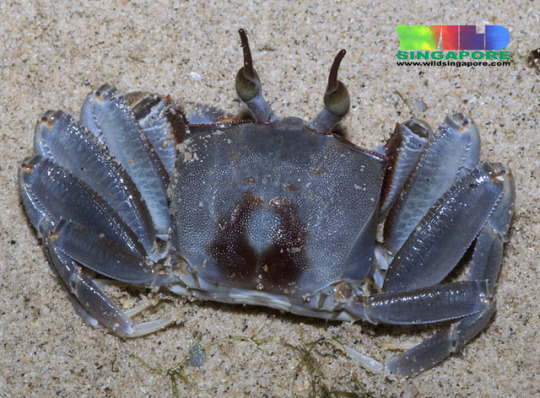


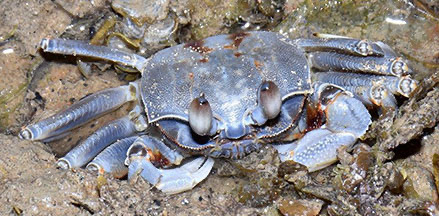
I’m pretty sure these guys can change color (becoming lighter during the day and darker at night) which reminds me of his position beside Chancellor Valorum vs Palpatine.
Another important feature is that ghost crab females have shorter horns in comparison to the males, and chagrians have similar sexual dimorphism with females being without horns.
19 notes
·
View notes
Photo
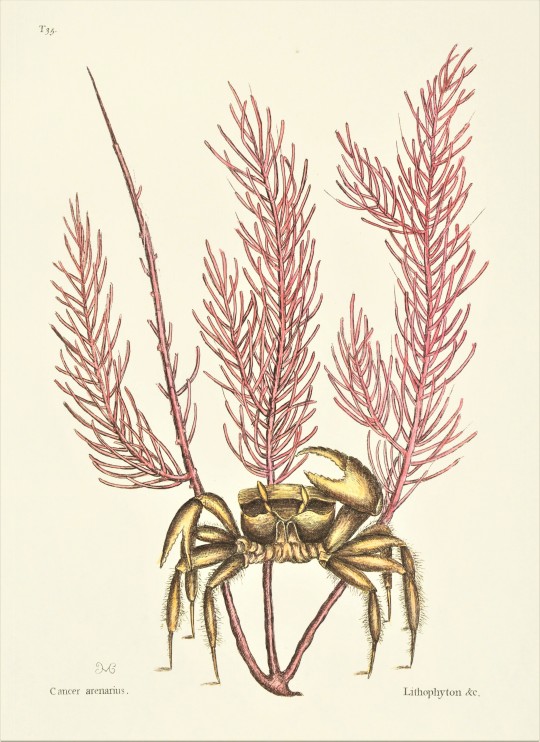
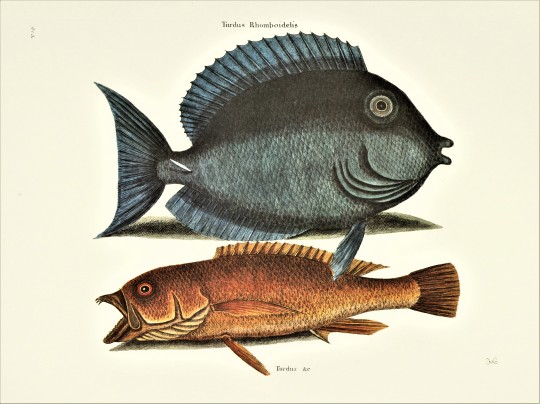



A Sea-Creature Science Saturday
We have featured quite a range of English Naturalist Mark Catesby’s avian specimens, but today we turn toward the sea. To be sure, both species of crabs shown above are terrestrial, but their lives begin in the ocean and they spend their lives Atlantic-adjacent, so we think it’s an acceptable grouping!
These plates come from our folio-sized facsimile of English Naturalist Mark Catesby’s The Natural History of Carolina, Florida, and the Bahama Islands, published in 1974 by Beehive Press of Savannah, Georgia in a limited run of 500 copies. It was designed and printed by The Stinehour Press in Vermont, and the fifty colored plates were printed at Meriden Gravure Company of Connecticut.
The plates above depict, from top to bottom:
Atlantic Ghost Crab (Ocypode quadrata), identified by Catesby as a Sand Crab (Cancer arenarius)
Upper: Atlantic Blue Tang (Acanthurus Coeruleus), called simply “the Tang” and classified Turdus Rhomboidalis by Catesby. Lower: Coney or Butterfish (Cephalopholis fulva), identified as “Yellow Fish” and classed as Turdus cauda convexa by Catesby.
Green Moray (Gymnothorax funebris).
Purple Land Crab (Gecarcinus ruricola), classified Cancer terrestris by Catesby.
Stoplight Parrotfish (Sparisoma viride).
You can read more about Mark Catesby and the making of his Natural History by reading our former intern Sarah’s post on the 1771 edition of The Natural History of Carolina, Florida, and the Bahama Islands.
More Catesby posts can be found here.
And find more Science Saturday posts here.
-Olivia, Special Collections Graduate Intern
#Science Saturday#Mark Catesby#The Natural History of Carolina Florida and the Bahama Islands#Natural History#Scientific Illustration#Etchings#The Beehive Press#Stinehour Press#Meriden Gravure Company#Ghost Crab#Blue Tang#Coney#Green Moray#Land Crab#Stoplight Parrotfish#olivia#facsimiles
73 notes
·
View notes
Text
Invertober continues!

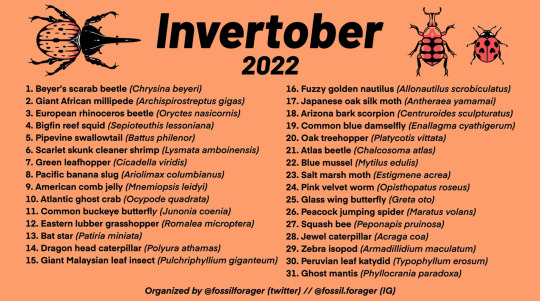
IMAGE TEXT:
Invertober 2022 Prompt List:
1. Beyer’s scarab beetle (Chrysina beyeri)
2. Giant African millipede (Archispirostreptus gigas)
3. European rhinoceros beetle (Oryctes nasicornis)
4. Bigfin reef squid (Sepioteuthis lessoniana)
5. Pipevine swallowtail (Battus philenor)
6. Scarlet skunk cleaner shrimp (Lysmata amboinensis)
7. Green leafhopper (Cicadella viridis)
8. Pacific banana slug (Ariolimax columbianus)
9. American comb jelly (Mnemiopsis leidyi)
10. Atlantic ghost crab (Ocypode quadrata)
11. Common buckeye butterfly (Junonia coenia)
12. Eastern lubber grasshopper (Romalea microptera)
13. Bat star (Patiria miniata)
14. Dragon head caterpillar (Polyura athamas)
15. Giant Malaysian leaf insect (Pulchriphyllium giganteum)
16. Fuzzy golden nautilus (Allonautilus scrobiculatus)
17. Japanese oak silk moth (Antheraea yamamai)
18. Arizona bark scorpion (Centruroides sculpturatus)
19. Common blue damselfly (Enallagma cyathigerum)
20. Oak treehopper (Platycotis vittata)
21. Atlas beetle (Chalcosoma atlas)
22. Blue mussel (Mytilus edulis)
23. Salt marsh moth (Estigmene acrea)
24. Pink velvet worm (Opisthopatus roseus)
25. Glass wing butterfly (Greta oto)
26. Peacock jumping spider (Maratus volans)
27. Squash bee (Peponapis pruinosa)
28. Jewel caterpillar (Acraga coa)
29. Zebra isopod (Armadillidium maculatum)
30. Peruvian leaf katydid (Typophyllum erosum)
31. Ghost mantis (Phyllocrania paradoxa)
47 notes
·
View notes
Text

100 Days of Sea Creatures Day 76 - Ghost Crab (Ocypode quadrata)
#artists on tumblr#artists on instagram#drawing challenge#sea creature art#drawing daily#sea creatures#crabs#crab art#ghost crab
1 note
·
View note
Text
Native Fish Hunting - Interlude!

So last week, the wife, parents and I took a family trip down to Florida. We like to head down to the Gulf coast about once a year; this time we went to Sanibel Island. Love it there - lots of shells and native life to see. Though we did see some neat Iguanas, Birds, and a handful of alligators, I’m focusing on the freshwater and brackish life! I have a handful of pictures to post, so hope you’ll enjoy over the next few days.

We stopped first in Tampa to go to the Dali Museum, but hey who can resist checking out the beach? Though I saw lots of fish I couldn’t get photos of (I believe Needlefish and Grunts) there was lots of neat flotsam and jetsam washed up. First was this little dude I recognize from back home - it’s Sea Lettuce (Ulva spp)! It’s a brackish tolerant algae (from about 1.011 to 1.025) that I also recently learned is also edible for humans. It can be dried and crushed for use as a salt substitute.
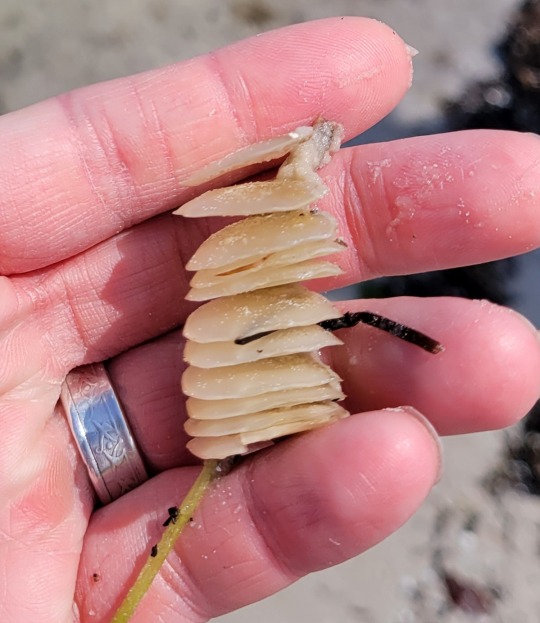
Also washed up are lots of egg cases from various molluscs. These are apparently from an American Crown Conch (Melongena corona); thanks iNaturalist! I just find these things neat.

I’m still trying to figure out what kind of algae this is... I’m fairly (?) certain that this is a Sargassum spp, but I suppose it could be a bleached out Laurencia spp. Either way, I like them.

These little guys are propagules (little baby trees) for the Red Mangrove (Rhizophora mangle) that you find a lot down here. While the adult trees themselves are protected, the propagules are generally fine to take unless you find them in a wildlife sanctuary. You plant the knobby brown ends down and hope the green ends sprout leaves. I took a dozen back on a previous trip as an experiment - not super hard to get started but I don’t recommend them as aquarium plants.

Skate eggs! I have a jar of them on the shelf from different locations and presumably different species - folks on iNaturalist think it might be a Clearnose Skate (Raja eglanteria) but heck if I know.

Lots of sponges washed up on the shore - I found a few that were bright orange and others that were this neato purple color. I’m not going to even guess about species here - I wouldn’t even know where to start - but I love them all the same.

Funny story, looking for shells (and keeping an eye out for stingrays), my wife had to shout and alert me to the crab I was about to step on. I thankfully didn’t. This guy is an Atlantic Ghost Crab (Ocypode quadrata), a very cool native species. Their closest relatives are the Fiddler Crabs you may see in aquarium stores - we have a few species local to VA.

A Lace Murex Shell (Chicoreus dilectus) I found! Apparently a rare shell in the area. I don’t know anything specific about them, I just wanted to share :)
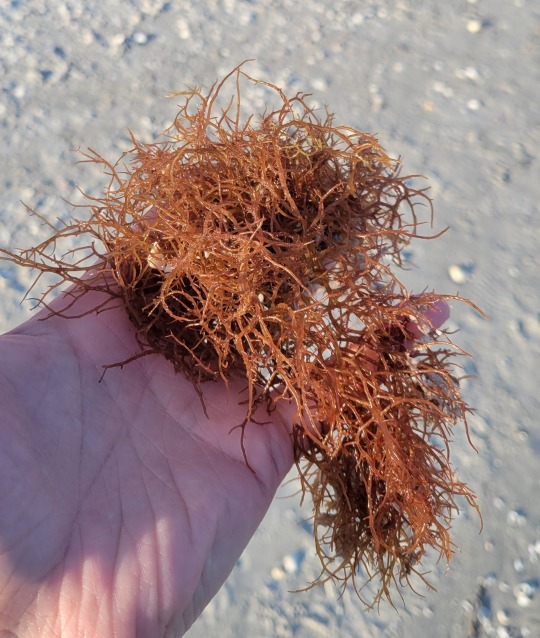
Pretty sure this is a Laurencia spp red algae. They do kind of look like a red version of Chaetomorpha or Gracilaria. I do wonder how well they would do in a brackish aquarium... but a brackish aquarium needing strong lights would be a rare sight.
22 notes
·
View notes
Text
¡#HolaCiencia! El nombre común de los #cangrejo fantasma y su género (Ocypode, “pies rápidos”) aluden a su velocidad: 100 veces su longitud corporal por seg., mas de 300 km/h si fueran humanos • pic.twitter.com/EJx7Y7G5lw vía @Rainmaker1973 #VideoCiencia Interesting science/FB 🦀👻
— Apuntes de ciencia (@ApuntesCiencia) December 13, 2021
4 notes
·
View notes